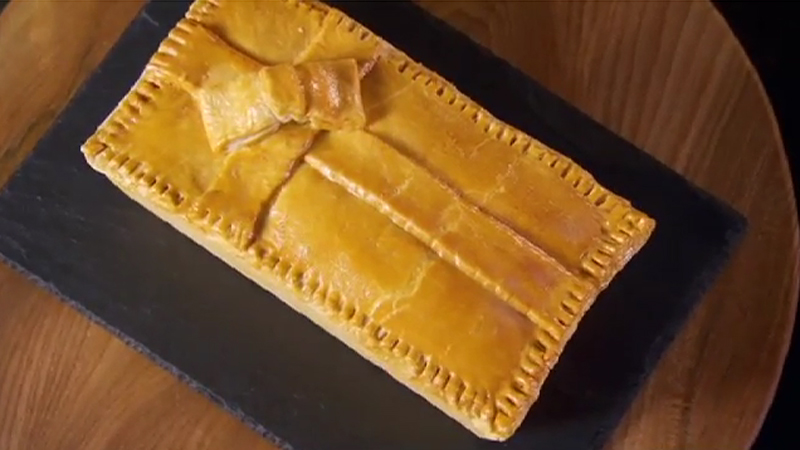Black Bun Delight - A Traditional Scottish Treat Explored
Discover the rich history, ingredients, and cultural significance of black bun. Learn how to make this traditional Scottish fruitcake with our comprehensive guide.
Author:Callum FraserMar 26, 202426.8K Shares368K Views

Black bunis a rich and dense Scottish fruitcake traditionally enjoyed during Hogmanay, the Scottish New Year’s Eve. Encased in a pastry shell, this delectable treat is filled with dried fruits, spices, and a touch of whisky, making it a flavorful symbol of Scottish heritage. In this comprehensive guide, we’ll delve into the history, ingredients, preparation methods, and cultural significance of black bun. By the end of this article, you’ll have all the knowledge needed to appreciate and possibly create your own black bun.
The History Of Black Bun
Origins
Black bun, originally known as "Scotch bun," has its roots in Scotland's rich culinary history. The treat dates back to the 16th century and was traditionally associated with Twelfth Night celebrations, marking the end of the Christmas season. Over time, black bun became more closely associated with Hogmanay, the Scottish New Year.
Hogmanay Tradition
During Hogmanay, it is customary to share black bun with family and friends as part of the festivities. The dense fruitcake symbolizes abundance and good fortune for the coming year. The tradition of "first footing," where the first visitor of the new year brings gifts such as black bun, whisky, and coal, further underscores the cake's cultural significance.
Ingredients Of Black Bun
Essential Ingredients
- Dried Fruits:Raisins, currants, sultanas, and sometimes chopped dates or figs.
- Spices:Cinnamon, nutmeg, allspice, and cloves for a warm, aromatic flavor.
- Flour:All-purpose flour for the cake and the pastry shell.
- Sugar:Brown sugar for a rich, caramel-like sweetness.
- Butter:Unsalted butter for both the filling and the pastry.
- Eggs:Provide structure and richness to the cake.
- Whisky:Adds a distinctive Scottish touch and enhances the flavors.
- Baking Powder:Helps the cake rise slightly, although it remains dense.
- Milk:Adds moisture to the pastry.
- Black Treacle (Molasses):For depth of flavor and color in the filling.
- Almonds:Chopped or ground almonds for texture and flavor.
Optional Additions
- Candied Peel:Adds a sweet and tangy flavor.
- Cherries:Glacé cherries for additional sweetness and texture.
- Orange Zest:Enhances the citrus notes in the cake.
How To Make Black Bun
Traditional Black Bun Recipe
Ingredients
For the Filling:
- 500g mixed dried fruits (raisins, currants, sultanas)
- 200g brown sugar
- 100g chopped almonds
- 1 tsp ground cinnamon
- 1 tsp ground nutmeg
- 1 tsp ground allspice
- 1/2 tsp ground cloves
- 2 tbsp black treacle (molasses)
- 2 tbsp Scotch whisky
- 2 large eggs
- 1 tsp baking powder
- 250g all-purpose flour
For the Pastry:
- 350g all-purpose flour
- 150g unsalted butter (cold, cut into cubes)
- 1 large egg
- 2-3 tbsp cold milk
- Pinch of salt
Instructions
- Prepare the Filling:
- Prepare the Pastry:
- Assemble the Black Bun:
- Bake the Black Bun:
Variations Of Black Bun
Gluten-Free Black Bun
Replace the all-purpose flour in both the filling and pastry with a gluten-free flour blend. Ensure all other ingredients are certified gluten-free.
Vegan Black Bun
Substitute the butter with a vegan margarine or coconut oil, and replace the eggs with flax eggs (1 tbsp ground flaxseed mixed with 3 tbsp water per egg). Use plant-based milk for the pastry.
Serving Suggestions
Traditional Hogmanay Celebration
Serve black bun as part of a traditional Hogmanay celebration, accompanied by a dram of Scotch whisky. Pair it with other Scottish delicacies such as shortbread, oatcakes, and cheese.
Afternoon Tea
Black bun makes a delightful addition to an afternoon tea spread. Serve with a selection of teas, such as Earl Grey or Darjeeling, to complement the rich, fruity flavors of the cake.
Gifting
Black bun is a thoughtful and traditional gift, particularly during the festive season. Wrap it in parchment paper and a decorative ribbon for a charming presentation.
Nutritional Information
A typical slice of black bun (based on 16 slices per cake) contains:
- Calories:300-350 kcal
- Protein:4-5g
- Fat:10-12g
- Carbohydrates:50-55g
- Sugar:30-35g
- Fiber:3-4g
Note: Nutritional values may vary based on specific ingredients and portion sizes.
Cultural Significance And Modern Relevance
Symbol Of Scottish Heritage
Black bun is more than just a cake; it is a symbol of Scottish heritage and tradition. Its presence at Hogmanay celebrations underscores its cultural importance and the sense of community and continuity it represents.
Modern Interpretations
While black bun remains a traditional treat, modern interpretations and variations have emerged. Chefs and home bakers alike experiment with different fruits, spices, and even dietary adaptations, ensuring that black bun continues to be enjoyed by new generations.
Global Appreciation
Scottish expatriates and enthusiasts of Scottish culturearound the world have embraced black bun, making it a global symbol of Scottish festivity. Its rich flavors and storied history make it a beloved treat far beyond Scotland’s borders.
FAQs About Black Bun
What Is Black Bun?
Black bun is a traditional Scottish fruitcake encased in a pastry shell. It is filled with dried fruits, spices, and often a touch of whisky, making it a rich and dense treat typically enjoyed during Hogmanay, the Scottish New Year’s Eve.
How Long Does Black Bun Last?
Black bun has a long shelf life due to its dense texture and high sugar content. When stored in an airtight container, it can last for several weeks. It is often best enjoyed after resting for a few days to allow the flavors to meld.
Can I Make Black Bun Without Whisky?
Yes, you can omit the whisky if you prefer. Substitute it with an equal amount of orange juice or apple juice to maintain the moisture and flavor balance.
What Is The Best Way To Serve Black Bun?
Black bun is traditionally served in slices at Hogmanay celebrations, often accompanied by a dram of Scotch whisky. It can also be enjoyed as part of an afternoon tea spread or given as a festive gift.
Can Black Bun Be Frozen?
Yes, black bun can be frozen. Wrap it tightly in plastic wrap and place it in an airtight container or freezer bag. It can be frozen for up to three months. Thaw at room temperature before serving.
Conclusion
Black bun is a quintessential Scottish treat, rich in history and flavor. Whether you’re celebrating Hogmanay, enjoying a special afternoon tea, or simply exploring new culinary traditions, black bun offers a unique and delightful experience. This guide has provided a comprehensive overview of its origins, preparation, and cultural significance, ensuring that you have all the information needed to appreciate and create your own black bun. Embrace this storied cake and share it with friends and family, keeping the tradition alive for generations to come.

Callum Fraser
Author
Callum Fraser isn't just a writer about Scotland; he's a product of its rugged landscape and rich history. Born and raised in Perthshire, with the Highlands as his backyard, his love for the nation's stories was kindled by local storytellers and long walks through ancient glens.
This passion led him to pursue a degree in Scottish History from the University of Edinburgh. For over 15 years, Callum has dedicated himself to exploring and documenting his homeland, fusing his academic knowledge with essential, on-the-ground experience gained from charting road trips through the Cairngorms, hiking the misty Cuillins of Skye, and uncovering the secrets of traditional recipes in his family's kitchen.
As the Editor-in-Chief and Lead Author for Scotland's Enchanting Kingdom, Callum's mission is simple: to be your most trusted guide. He combines meticulous research with a storyteller's heart to help you discover the authentic magic of Scotland — from its best-kept travel secrets to its most cherished traditional recipes.
Latest Articles
Popular Articles